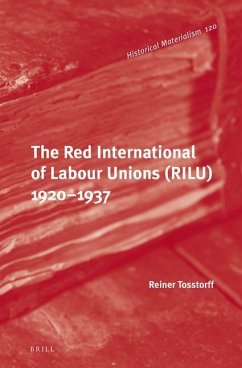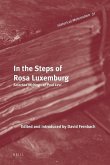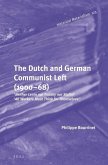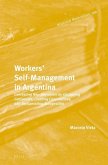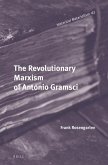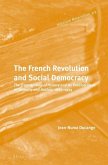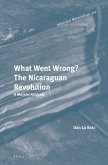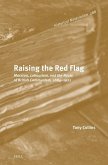Reiner Tosstorff
The Red International of Labour Unions (Rilu) 1920 - 1937
Reiner Tosstorff
The Red International of Labour Unions (Rilu) 1920 - 1937
- Gebundenes Buch
- Merkliste
- Auf die Merkliste
- Bewerten Bewerten
- Teilen
- Produkt teilen
- Produkterinnerung
- Produkterinnerung
Based on extensive archive research, this first comprehensive history of the Red International of Labour Unions looks at the contribution of communism to the international trade union movement in the interwar years.
Andere Kunden interessierten sich auch für
![In the Steps of Rosa Luxemburg In the Steps of Rosa Luxemburg]() Paul LeviIn the Steps of Rosa Luxemburg183,99 €
Paul LeviIn the Steps of Rosa Luxemburg183,99 €![The Dutch and German Communist Left (1900-68) The Dutch and German Communist Left (1900-68)]() Philippe BourrinetThe Dutch and German Communist Left (1900-68)308,99 €
Philippe BourrinetThe Dutch and German Communist Left (1900-68)308,99 €![Workers' Self-Management in Argentina Workers' Self-Management in Argentina]() Marcelo VietaWorkers' Self-Management in Argentina272,99 €
Marcelo VietaWorkers' Self-Management in Argentina272,99 €![The Revolutionary Marxism of Antonio Gramsci The Revolutionary Marxism of Antonio Gramsci]() Frank RosengartenThe Revolutionary Marxism of Antonio Gramsci176,99 €
Frank RosengartenThe Revolutionary Marxism of Antonio Gramsci176,99 €![The French Revolution and Social Democracy The French Revolution and Social Democracy]() Jean-Numa DucangeThe French Revolution and Social Democracy225,99 €
Jean-Numa DucangeThe French Revolution and Social Democracy225,99 €![What Went Wrong? the Nicaraguan Revolution What Went Wrong? the Nicaraguan Revolution]() Dan La BotzWhat Went Wrong? the Nicaraguan Revolution236,99 €
Dan La BotzWhat Went Wrong? the Nicaraguan Revolution236,99 €![Raising the Red Flag Raising the Red Flag]() Tony CollinsRaising the Red Flag185,99 €
Tony CollinsRaising the Red Flag185,99 €-
-
-
Based on extensive archive research, this first comprehensive history of the Red International of Labour Unions looks at the contribution of communism to the international trade union movement in the interwar years.
Hinweis: Dieser Artikel kann nur an eine deutsche Lieferadresse ausgeliefert werden.
Hinweis: Dieser Artikel kann nur an eine deutsche Lieferadresse ausgeliefert werden.
Produktdetails
- Produktdetails
- Verlag: Brill
- Seitenzahl: 936
- Erscheinungstermin: 8. September 2016
- Englisch
- Abmessung: 239mm x 157mm x 53mm
- Gewicht: 1406g
- ISBN-13: 9789004236646
- ISBN-10: 9004236643
- Artikelnr.: 45014696
- Herstellerkennzeichnung
- Libri GmbH
- Europaallee 1
- 36244 Bad Hersfeld
- 06621 890
- Verlag: Brill
- Seitenzahl: 936
- Erscheinungstermin: 8. September 2016
- Englisch
- Abmessung: 239mm x 157mm x 53mm
- Gewicht: 1406g
- ISBN-13: 9789004236646
- ISBN-10: 9004236643
- Artikelnr.: 45014696
- Herstellerkennzeichnung
- Libri GmbH
- Europaallee 1
- 36244 Bad Hersfeld
- 06621 890
Reiner Tosstorff, Dr. phil. habil., teaches at the history department at Johannes Gutenberg University Mainz. He has published monographs and articles on Spanish history as well as on the international workers' movement in the twentieth century.
ACKNOWLEDGEMENTS
ABBREVIATIONS
INTRODUCTION
1. FROM TRADE UNION INTERNATIONALISM TO THE INTERNATIONAL FEDERATION OF
TRADE UNIONS
2. IN SEARCH OF A REVOLUTIONARY TRADE UNION INTERNATIONAL
2.1 The International Politics of the All-Russian Central Council of Trade
Unions 1917-20
2.2 The Communist International and the Trade-Union Question
2.3 The Impact of the October Revolution on the Revolutionary Syndicalists
2.4 The First Trade Union Contacts: The Question of the International Trade
Secretariats and Shliapnikov's Mission
3. THE INTERNATIONAL TRADE UNION COUNCIL (1920-1)
3.1 Its Foundation
3.2 The Sequel: The Second Comintern Congress and the Trade-Union Question
3.3 The Organisation of the International Trade Union Council
3.4 The Foreign Delegations of the VTsSPS in Autumn 1920: Making Propaganda
for the International Trade Union Council
3.5 'Amsterdam' or 'Moscow': The Course of the Argument within the IFTU
after the Foundation of the International Trade Union Council
3.6 The Syndicalists En Route for Moscow
3.7 The International Trade Union Council, 1920-1: Its Programme,
Activities and Organisation
3.8 Towards the Founding Congress: Discussions Between the ITUC and the
Delegates
3.9 The Russian Trade Unions and the International Trade Secretariats,
1920-1
4. THE FOUNDING CONGRESS OF THE RED INTERNATIONAL OF LABOUR UNIONS
4.1 The Course of the Congress: The RILU is Established
4.2 Relations Between the Comintern and the RILU
4.3 The Tactics, Organisation and Statutes of the RILU
4.4 The First RILU Congress Draws to a Conclusion
4.5 The Syndicalist Opposition and the Question of the Anarchist Prisoners
4.6 Excursus: The Trade Union Discussion at the Third Comintern Congress
4.7 The Formation of the RILU Leadership: The First Session of the Central
Council
4.8 The Creation of the International Propaganda Committees
5. FROM THE FIRST TO THE SECOND CONGRESS OF THE RILU
5.1 Should the RILU Be Disbanded? Resignations and Demands for Liquidation
5.2 The Syndicalists between Moscow and Berlin
5.3 The Development of the RILU as an Organisation and a Political
Entity: From the First to the Second Congress
5.4 The International Trade Secretariats and the International Propaganda
Committees, 1921-2
5.5 The Second Congress of the Red International of Labour Unions
5.6 Excursus: Organisational Connections Grow Closer: The RILU becomes the
Comintern's International Trade Union Apparatus
6. THE UNITED FRONT THAT DIDN'T HAPPEN IN 1923: THE ROLE OF THE RILU
6.1 From the Hague Congress to the Ruhr Crisis: Fimmen Breaks Ranks
6.2 The Attempt to Achieve the United Front through the International Trade
Secretariats
6.3 The Third Session of the Central Council
6.4 A 'German October'? The Lessons of Defeat
6.5 The RILU as an Organisation at the Beginning of 1924: An Interim
Summary
7. THE RILU BETWEEN 1924 AND 1927: IN DANGER OF DISSOLUTION FOR THE SAKE OF
INTERNATIONAL TRADE UNION UNITY
7.1 The Trades Union Congress Brings About a Turn to the Left in the IFTU
7.2 Moscow Takes the Road to Unity: The Fifth Comintern Congress and the
Third RILU Congress
7.3 The Anglo-Russian Committee and the International Movement for Trade
Union Unity
7.4 The Fourth Session of the Central Council
7.5 A Way to Gain New Influence? Initiatives Taken by the RILU Leadership
in China and Other Countries
8. THE RILU IN THE CONTEXT OF THE 'ULTRA-LEFT' POLICY OF INTERNATIONAL
COMMUNISM 1928-34
8.1 Trotskyist Opposition in the RILU? The Nin Affair and the Rift with the
Dutch Leftists
8.2 The Radicalisation of the RILU's Course by Lozovsky and the Sanctioning
of the New Approach by the Fourth Congress
8.3 The New Line is Applied Across the Board
8.4 The Sixth Session of the Central Council, The Fifth RILU Congress and
the Eighth Session of the Central Council
8.5 Organisational Inflation as a Compensation for Political Decline
9. THE END OF THE ROAD: THE RILU FROM 1934-7
9.1 Trade-Union Unity Under the Banner of the Turn to the Popular Front
9.2 The Seventh Comintern Congress and the International Trade Union
Discussion
9.3 The Dissolution of the RILU
9.4 The Sequel: The Russian Trade Unions Again Attempt to Enter the IFTU
CONCLUSION
APPENDICES
Appendix 1: Lozovsky and the Bolsheviks before 1920: A Biographical Sketch
Appendix 2: Biographies of Other Leading Figures
BIBLIOGRAPHY
INDICES
Index of Names
Index of Trade Union Organisations
ABBREVIATIONS
INTRODUCTION
1. FROM TRADE UNION INTERNATIONALISM TO THE INTERNATIONAL FEDERATION OF
TRADE UNIONS
2. IN SEARCH OF A REVOLUTIONARY TRADE UNION INTERNATIONAL
2.1 The International Politics of the All-Russian Central Council of Trade
Unions 1917-20
2.2 The Communist International and the Trade-Union Question
2.3 The Impact of the October Revolution on the Revolutionary Syndicalists
2.4 The First Trade Union Contacts: The Question of the International Trade
Secretariats and Shliapnikov's Mission
3. THE INTERNATIONAL TRADE UNION COUNCIL (1920-1)
3.1 Its Foundation
3.2 The Sequel: The Second Comintern Congress and the Trade-Union Question
3.3 The Organisation of the International Trade Union Council
3.4 The Foreign Delegations of the VTsSPS in Autumn 1920: Making Propaganda
for the International Trade Union Council
3.5 'Amsterdam' or 'Moscow': The Course of the Argument within the IFTU
after the Foundation of the International Trade Union Council
3.6 The Syndicalists En Route for Moscow
3.7 The International Trade Union Council, 1920-1: Its Programme,
Activities and Organisation
3.8 Towards the Founding Congress: Discussions Between the ITUC and the
Delegates
3.9 The Russian Trade Unions and the International Trade Secretariats,
1920-1
4. THE FOUNDING CONGRESS OF THE RED INTERNATIONAL OF LABOUR UNIONS
4.1 The Course of the Congress: The RILU is Established
4.2 Relations Between the Comintern and the RILU
4.3 The Tactics, Organisation and Statutes of the RILU
4.4 The First RILU Congress Draws to a Conclusion
4.5 The Syndicalist Opposition and the Question of the Anarchist Prisoners
4.6 Excursus: The Trade Union Discussion at the Third Comintern Congress
4.7 The Formation of the RILU Leadership: The First Session of the Central
Council
4.8 The Creation of the International Propaganda Committees
5. FROM THE FIRST TO THE SECOND CONGRESS OF THE RILU
5.1 Should the RILU Be Disbanded? Resignations and Demands for Liquidation
5.2 The Syndicalists between Moscow and Berlin
5.3 The Development of the RILU as an Organisation and a Political
Entity: From the First to the Second Congress
5.4 The International Trade Secretariats and the International Propaganda
Committees, 1921-2
5.5 The Second Congress of the Red International of Labour Unions
5.6 Excursus: Organisational Connections Grow Closer: The RILU becomes the
Comintern's International Trade Union Apparatus
6. THE UNITED FRONT THAT DIDN'T HAPPEN IN 1923: THE ROLE OF THE RILU
6.1 From the Hague Congress to the Ruhr Crisis: Fimmen Breaks Ranks
6.2 The Attempt to Achieve the United Front through the International Trade
Secretariats
6.3 The Third Session of the Central Council
6.4 A 'German October'? The Lessons of Defeat
6.5 The RILU as an Organisation at the Beginning of 1924: An Interim
Summary
7. THE RILU BETWEEN 1924 AND 1927: IN DANGER OF DISSOLUTION FOR THE SAKE OF
INTERNATIONAL TRADE UNION UNITY
7.1 The Trades Union Congress Brings About a Turn to the Left in the IFTU
7.2 Moscow Takes the Road to Unity: The Fifth Comintern Congress and the
Third RILU Congress
7.3 The Anglo-Russian Committee and the International Movement for Trade
Union Unity
7.4 The Fourth Session of the Central Council
7.5 A Way to Gain New Influence? Initiatives Taken by the RILU Leadership
in China and Other Countries
8. THE RILU IN THE CONTEXT OF THE 'ULTRA-LEFT' POLICY OF INTERNATIONAL
COMMUNISM 1928-34
8.1 Trotskyist Opposition in the RILU? The Nin Affair and the Rift with the
Dutch Leftists
8.2 The Radicalisation of the RILU's Course by Lozovsky and the Sanctioning
of the New Approach by the Fourth Congress
8.3 The New Line is Applied Across the Board
8.4 The Sixth Session of the Central Council, The Fifth RILU Congress and
the Eighth Session of the Central Council
8.5 Organisational Inflation as a Compensation for Political Decline
9. THE END OF THE ROAD: THE RILU FROM 1934-7
9.1 Trade-Union Unity Under the Banner of the Turn to the Popular Front
9.2 The Seventh Comintern Congress and the International Trade Union
Discussion
9.3 The Dissolution of the RILU
9.4 The Sequel: The Russian Trade Unions Again Attempt to Enter the IFTU
CONCLUSION
APPENDICES
Appendix 1: Lozovsky and the Bolsheviks before 1920: A Biographical Sketch
Appendix 2: Biographies of Other Leading Figures
BIBLIOGRAPHY
INDICES
Index of Names
Index of Trade Union Organisations
ACKNOWLEDGEMENTS
ABBREVIATIONS
INTRODUCTION
1. FROM TRADE UNION INTERNATIONALISM TO THE INTERNATIONAL FEDERATION OF
TRADE UNIONS
2. IN SEARCH OF A REVOLUTIONARY TRADE UNION INTERNATIONAL
2.1 The International Politics of the All-Russian Central Council of Trade
Unions 1917-20
2.2 The Communist International and the Trade-Union Question
2.3 The Impact of the October Revolution on the Revolutionary Syndicalists
2.4 The First Trade Union Contacts: The Question of the International Trade
Secretariats and Shliapnikov's Mission
3. THE INTERNATIONAL TRADE UNION COUNCIL (1920-1)
3.1 Its Foundation
3.2 The Sequel: The Second Comintern Congress and the Trade-Union Question
3.3 The Organisation of the International Trade Union Council
3.4 The Foreign Delegations of the VTsSPS in Autumn 1920: Making Propaganda
for the International Trade Union Council
3.5 'Amsterdam' or 'Moscow': The Course of the Argument within the IFTU
after the Foundation of the International Trade Union Council
3.6 The Syndicalists En Route for Moscow
3.7 The International Trade Union Council, 1920-1: Its Programme,
Activities and Organisation
3.8 Towards the Founding Congress: Discussions Between the ITUC and the
Delegates
3.9 The Russian Trade Unions and the International Trade Secretariats,
1920-1
4. THE FOUNDING CONGRESS OF THE RED INTERNATIONAL OF LABOUR UNIONS
4.1 The Course of the Congress: The RILU is Established
4.2 Relations Between the Comintern and the RILU
4.3 The Tactics, Organisation and Statutes of the RILU
4.4 The First RILU Congress Draws to a Conclusion
4.5 The Syndicalist Opposition and the Question of the Anarchist Prisoners
4.6 Excursus: The Trade Union Discussion at the Third Comintern Congress
4.7 The Formation of the RILU Leadership: The First Session of the Central
Council
4.8 The Creation of the International Propaganda Committees
5. FROM THE FIRST TO THE SECOND CONGRESS OF THE RILU
5.1 Should the RILU Be Disbanded? Resignations and Demands for Liquidation
5.2 The Syndicalists between Moscow and Berlin
5.3 The Development of the RILU as an Organisation and a Political
Entity: From the First to the Second Congress
5.4 The International Trade Secretariats and the International Propaganda
Committees, 1921-2
5.5 The Second Congress of the Red International of Labour Unions
5.6 Excursus: Organisational Connections Grow Closer: The RILU becomes the
Comintern's International Trade Union Apparatus
6. THE UNITED FRONT THAT DIDN'T HAPPEN IN 1923: THE ROLE OF THE RILU
6.1 From the Hague Congress to the Ruhr Crisis: Fimmen Breaks Ranks
6.2 The Attempt to Achieve the United Front through the International Trade
Secretariats
6.3 The Third Session of the Central Council
6.4 A 'German October'? The Lessons of Defeat
6.5 The RILU as an Organisation at the Beginning of 1924: An Interim
Summary
7. THE RILU BETWEEN 1924 AND 1927: IN DANGER OF DISSOLUTION FOR THE SAKE OF
INTERNATIONAL TRADE UNION UNITY
7.1 The Trades Union Congress Brings About a Turn to the Left in the IFTU
7.2 Moscow Takes the Road to Unity: The Fifth Comintern Congress and the
Third RILU Congress
7.3 The Anglo-Russian Committee and the International Movement for Trade
Union Unity
7.4 The Fourth Session of the Central Council
7.5 A Way to Gain New Influence? Initiatives Taken by the RILU Leadership
in China and Other Countries
8. THE RILU IN THE CONTEXT OF THE 'ULTRA-LEFT' POLICY OF INTERNATIONAL
COMMUNISM 1928-34
8.1 Trotskyist Opposition in the RILU? The Nin Affair and the Rift with the
Dutch Leftists
8.2 The Radicalisation of the RILU's Course by Lozovsky and the Sanctioning
of the New Approach by the Fourth Congress
8.3 The New Line is Applied Across the Board
8.4 The Sixth Session of the Central Council, The Fifth RILU Congress and
the Eighth Session of the Central Council
8.5 Organisational Inflation as a Compensation for Political Decline
9. THE END OF THE ROAD: THE RILU FROM 1934-7
9.1 Trade-Union Unity Under the Banner of the Turn to the Popular Front
9.2 The Seventh Comintern Congress and the International Trade Union
Discussion
9.3 The Dissolution of the RILU
9.4 The Sequel: The Russian Trade Unions Again Attempt to Enter the IFTU
CONCLUSION
APPENDICES
Appendix 1: Lozovsky and the Bolsheviks before 1920: A Biographical Sketch
Appendix 2: Biographies of Other Leading Figures
BIBLIOGRAPHY
INDICES
Index of Names
Index of Trade Union Organisations
ABBREVIATIONS
INTRODUCTION
1. FROM TRADE UNION INTERNATIONALISM TO THE INTERNATIONAL FEDERATION OF
TRADE UNIONS
2. IN SEARCH OF A REVOLUTIONARY TRADE UNION INTERNATIONAL
2.1 The International Politics of the All-Russian Central Council of Trade
Unions 1917-20
2.2 The Communist International and the Trade-Union Question
2.3 The Impact of the October Revolution on the Revolutionary Syndicalists
2.4 The First Trade Union Contacts: The Question of the International Trade
Secretariats and Shliapnikov's Mission
3. THE INTERNATIONAL TRADE UNION COUNCIL (1920-1)
3.1 Its Foundation
3.2 The Sequel: The Second Comintern Congress and the Trade-Union Question
3.3 The Organisation of the International Trade Union Council
3.4 The Foreign Delegations of the VTsSPS in Autumn 1920: Making Propaganda
for the International Trade Union Council
3.5 'Amsterdam' or 'Moscow': The Course of the Argument within the IFTU
after the Foundation of the International Trade Union Council
3.6 The Syndicalists En Route for Moscow
3.7 The International Trade Union Council, 1920-1: Its Programme,
Activities and Organisation
3.8 Towards the Founding Congress: Discussions Between the ITUC and the
Delegates
3.9 The Russian Trade Unions and the International Trade Secretariats,
1920-1
4. THE FOUNDING CONGRESS OF THE RED INTERNATIONAL OF LABOUR UNIONS
4.1 The Course of the Congress: The RILU is Established
4.2 Relations Between the Comintern and the RILU
4.3 The Tactics, Organisation and Statutes of the RILU
4.4 The First RILU Congress Draws to a Conclusion
4.5 The Syndicalist Opposition and the Question of the Anarchist Prisoners
4.6 Excursus: The Trade Union Discussion at the Third Comintern Congress
4.7 The Formation of the RILU Leadership: The First Session of the Central
Council
4.8 The Creation of the International Propaganda Committees
5. FROM THE FIRST TO THE SECOND CONGRESS OF THE RILU
5.1 Should the RILU Be Disbanded? Resignations and Demands for Liquidation
5.2 The Syndicalists between Moscow and Berlin
5.3 The Development of the RILU as an Organisation and a Political
Entity: From the First to the Second Congress
5.4 The International Trade Secretariats and the International Propaganda
Committees, 1921-2
5.5 The Second Congress of the Red International of Labour Unions
5.6 Excursus: Organisational Connections Grow Closer: The RILU becomes the
Comintern's International Trade Union Apparatus
6. THE UNITED FRONT THAT DIDN'T HAPPEN IN 1923: THE ROLE OF THE RILU
6.1 From the Hague Congress to the Ruhr Crisis: Fimmen Breaks Ranks
6.2 The Attempt to Achieve the United Front through the International Trade
Secretariats
6.3 The Third Session of the Central Council
6.4 A 'German October'? The Lessons of Defeat
6.5 The RILU as an Organisation at the Beginning of 1924: An Interim
Summary
7. THE RILU BETWEEN 1924 AND 1927: IN DANGER OF DISSOLUTION FOR THE SAKE OF
INTERNATIONAL TRADE UNION UNITY
7.1 The Trades Union Congress Brings About a Turn to the Left in the IFTU
7.2 Moscow Takes the Road to Unity: The Fifth Comintern Congress and the
Third RILU Congress
7.3 The Anglo-Russian Committee and the International Movement for Trade
Union Unity
7.4 The Fourth Session of the Central Council
7.5 A Way to Gain New Influence? Initiatives Taken by the RILU Leadership
in China and Other Countries
8. THE RILU IN THE CONTEXT OF THE 'ULTRA-LEFT' POLICY OF INTERNATIONAL
COMMUNISM 1928-34
8.1 Trotskyist Opposition in the RILU? The Nin Affair and the Rift with the
Dutch Leftists
8.2 The Radicalisation of the RILU's Course by Lozovsky and the Sanctioning
of the New Approach by the Fourth Congress
8.3 The New Line is Applied Across the Board
8.4 The Sixth Session of the Central Council, The Fifth RILU Congress and
the Eighth Session of the Central Council
8.5 Organisational Inflation as a Compensation for Political Decline
9. THE END OF THE ROAD: THE RILU FROM 1934-7
9.1 Trade-Union Unity Under the Banner of the Turn to the Popular Front
9.2 The Seventh Comintern Congress and the International Trade Union
Discussion
9.3 The Dissolution of the RILU
9.4 The Sequel: The Russian Trade Unions Again Attempt to Enter the IFTU
CONCLUSION
APPENDICES
Appendix 1: Lozovsky and the Bolsheviks before 1920: A Biographical Sketch
Appendix 2: Biographies of Other Leading Figures
BIBLIOGRAPHY
INDICES
Index of Names
Index of Trade Union Organisations

